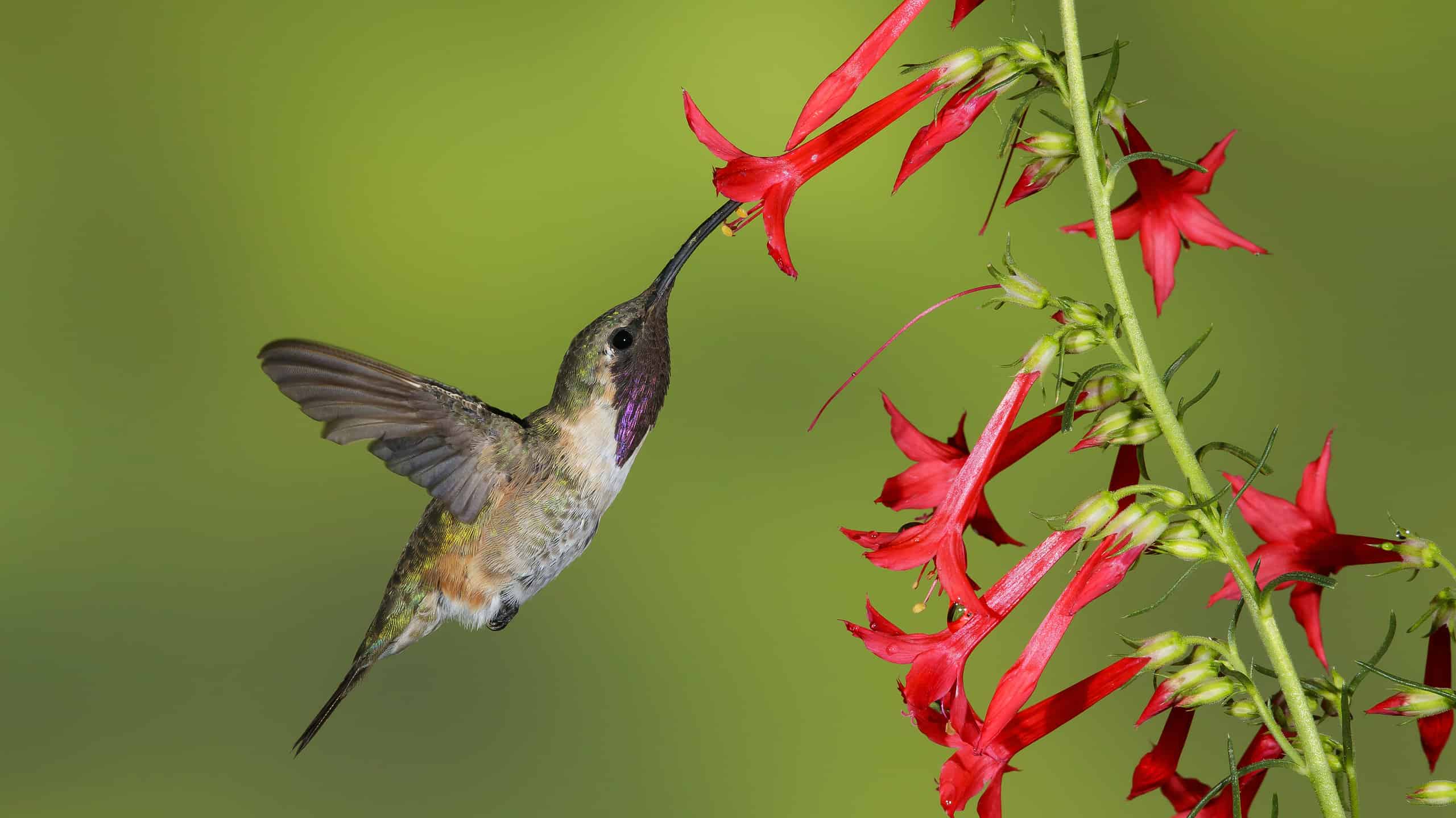Combine vibrant ruby gems and the mesmerizing flight of hummingbirds, the tiny avian wonders. Transform your garden into a haven for these graceful creatures. Discover eighteen beautiful red flowers that attract hummingbirds, each with its own unique allure. From the elegant bee balm and cardinal flower to the exotic Turk’s cap and bat-faced cuphea, these blossoms not only paint your garden with vibrant shades of red but also provide a delectable nectar source that will keep hummingbirds visiting year after year.
1. Bat-Faced Cuphea (Cuphea llavia)
Bat-faced cuphea is more charming than its name suggests. This perennial is known for its unique, bat-like flowers. It is a compact, bushy plant that features small, tubular red blooms. The unique flowers are small but striking. They consist of tubular petals with a contrasting “face” pattern that resembles a bat’s face, complete with ears.
Additionally, bat-faced cuphea’s foliage is lance-shaped and contributes to the plant’s bushy appearance. The perennial prefers full sun to partial shade and reaches up to 2 feet. However, it produces more blooms when exposed to ample sunlight. Rich, well-draining soil is essential. Additionally, keep the soil consistently moist but not waterlogged. Regular watering is important, especially during dry spells.
Bat-faced cuphea’s compact growth habit makes it perfect for bordering garden beds or edging walkways. It also thrives in containers, making it an excellent choice for patio gardens or balcony planters. Furthermore, its low, mounding form makes it suitable for rock gardens, where it can create a striking contrast.
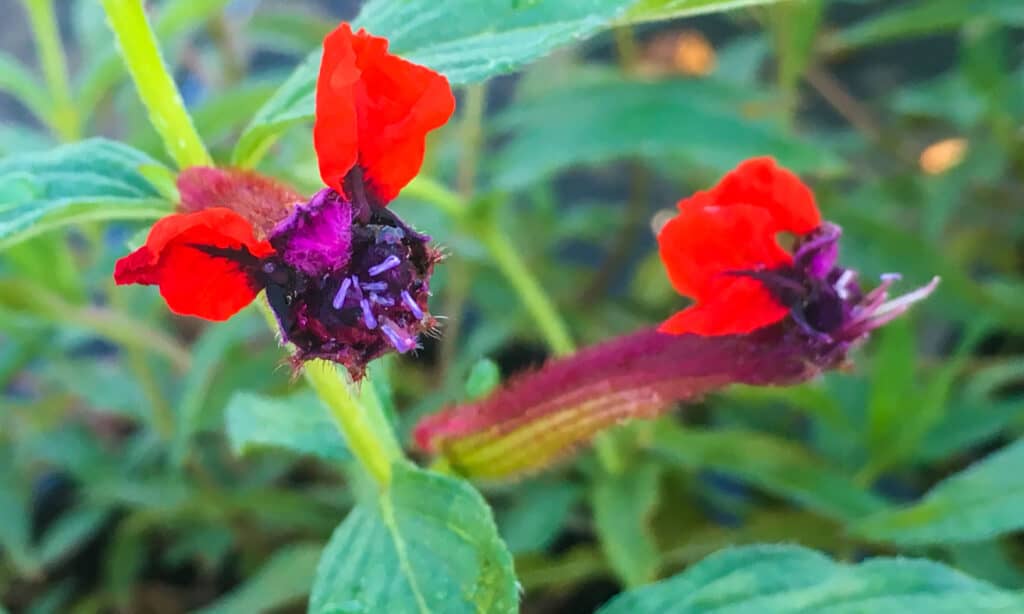
Bat-faced cuphea’s foliage tolerates light frost.
©Matt Howard/Shutterstock.com
2. Cardinal Flower (Lobelia cardinalis)
The cardinal flower is another captivating native perennial that stands tall with its brilliant red blossoms. This striking plant, reaching up to 4 feet, makes a bold statement in any garden. The tubular-shaped, scarlet-red flowers are a hummingbird magnet, while the plant’s lance-shaped leaves provide an attractive backdrop for its stunning blooms.
The name “cardinal flower” is derived from the bright red color of the robes worn by Roman Catholic cardinals. Specimens grow best in moist to wet conditions, making it an ideal choice for planting near ponds, streams, or rain gardens. However, they require well-draining soil.
Additionally, use cardinal flowers as vertical accents in perennial borders. Their dramatic height and striking red color provide a bold contrast to other garden plants. Deadhead spent flowers to encourage additional blooming and cut back the plant in late fall or early spring to promote healthy new growth.
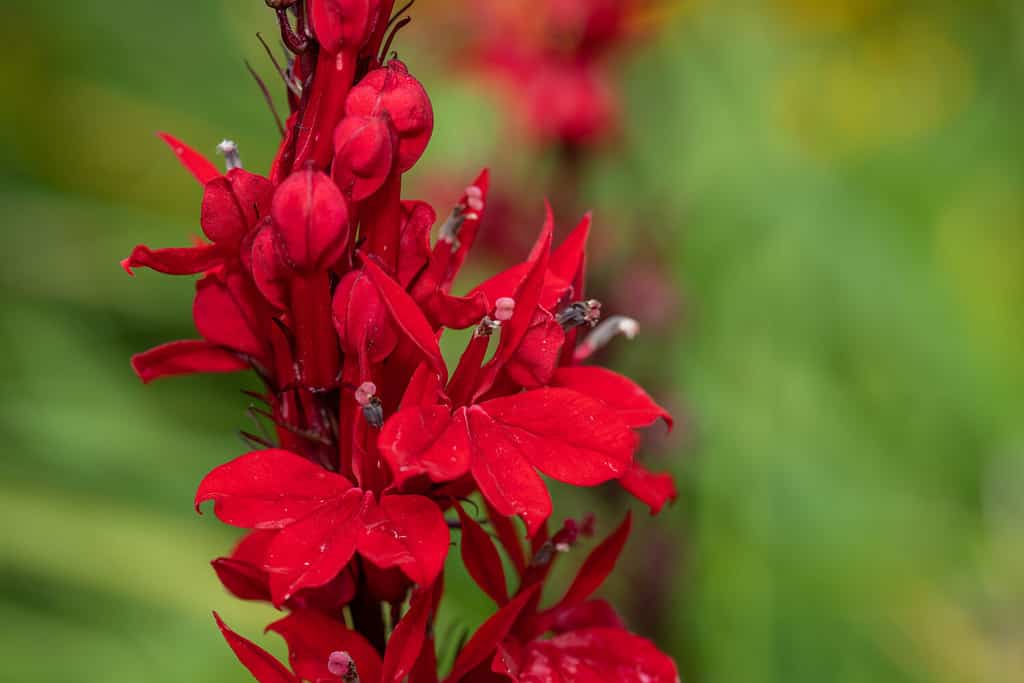
Native Americans used cardinal flowers for medicinal purposes.
©Tom Meaker/Shutterstock.com
3. Coral Honeysuckle (Lonicera sempervirens)
Another North American native, coral honeysuckle, is a climbing vine that adds charm and color to outdoor spaces. This perennial vine produces clusters of vibrant tubular flowers, making it a favorite among hummingbirds and garden enthusiasts alike. Additionally, its blooms are bright red to orange-red and 1 to 1.5 inches long.
Furthermore, its flower clusters appear in late spring and continue blooming into early summer. The oblong leaves of coral honeysuckle are semi-evergreen, depending on the climate. Coral honeysuckle has a climbing and twining growth habit and reaches to 20 feet.
Specimens grow best in full to partial sun and well-draining soil. Furthermore, they are drought-tolerant once established. However, since coral honeysuckle is a climbing vine, it requires a support structure like a trellis or arbor to grow on.
Train Coral Honeysuckle to climb arbors, trellises, or fences, creating vertical interest. It is also an excellent choice for native plant gardens or naturalized landscapes. Prune the vine in late winter or early spring to remove dead or overgrown branches and to shape it as desired.
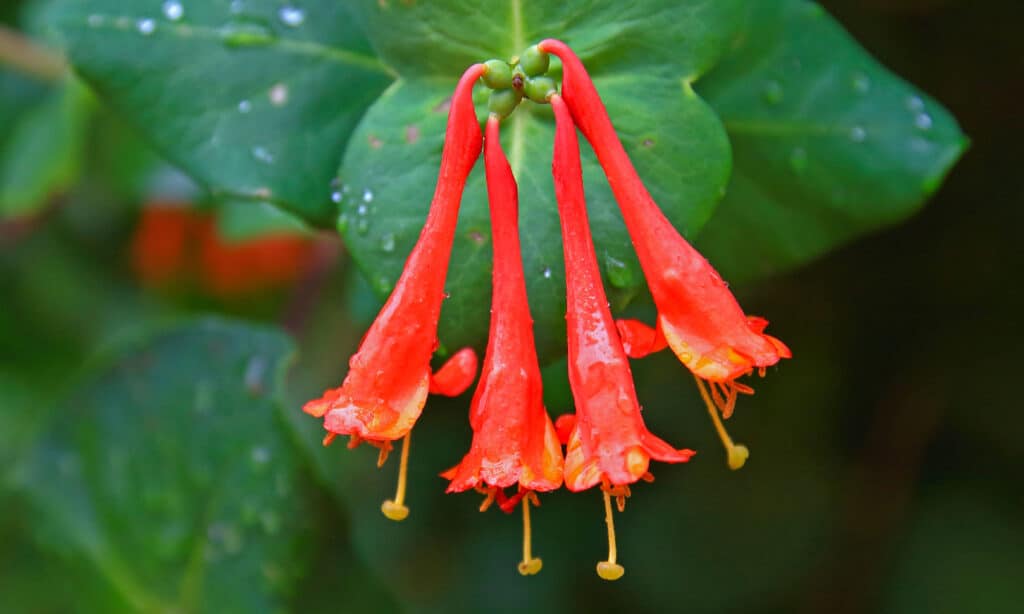
Coral honeysuckle is a hardy vine but not aggressive.
©iStock.com/Vera Tikhonova
4. Firecracker Penstemon (Penstemon eatonii)
Native to the western United States, firecracker penstemon is another captivating perennial plant. This wildflower earns its name from its vibrant flowers, which closely resemble a cluster of firecrackers. Its striking appearance and hummingbird-friendly blooms make it a popular choice for wildflower gardens and xeriscapes.
Firecracker penstemon produces bright red tubular flowers arranged in tall spikes. It also produces lance-shaped, medium-green leaves to form a dense mound. Incorporate this native beauty into wildflower gardens to add a burst of red color and attract hummingbirds and pollinators.
The perennial is also drought-tolerant and thrives in xeriscape gardens, where water conservation is essential. Furthermore, its low, mounding growth habit makes it suitable for rock gardens or as a ground cover in rocky terrain. Mature specimens only reach up to 2 feet.
Full sun conditions provide the best blooms, and well-draining soil is crucial. Deadhead spent flowers to encourage additional blooming and cut back the plant in late fall or early spring to promote growth.

Firecracker penstemon thrives in desert regions.
©Matt Lavin, CC BY-SA 2.0 , via Wikimedia Commons – Original / License
5. Firecracker Plant (Russelia equisetiformis)
Also known as the coral plant, the firecracker plant is an ornamental shrub that ignites the garden with its fiery red blooms. Native to Mexico, this perennial plant resembles bursts of red firecrackers, making it an exciting choice for hummingbird gardens. It produces bright red to coral-red tubular flower clusters, resembling a cascade of firecrackers. These blossoms are also rich in nectar and perfectly designed to attract hummingbirds.
The plant also features fine, feathery foliage with a delicate appearance. Firecracker plant grows best in full sun but tolerates partial shade. It requires well-draining soil. However, it thrives with consistent moisture and requires regular watering. Additionally, prune the plant as needed to maintain its shape and encourage continuous blooming. Deadheading spent flowers also promotes extended blooming.
Its arching and cascading growth habit makes it an excellent choice for borders and hedges, creating a dramatic visual effect when in full bloom. Furthermore, firecracker plants also thrive in hanging baskets, where their pendulous branches and vibrant blooms can spill over the edges.

Firecracker plant is a bushy subshrub with a weeping form.
©mark higgins/Shutterstock.com
6. Flame Acanthus (Anisacanthus quadrifidus var. wrightii)
Flame acanthus, also known as desert honeysuckle, is a striking native shrub that adds a fiery touch to your garden. This deciduous perennial boasts vibrant red, tubular flowers that attract hummingbirds and other pollinators. Its unique appearance and adaptability make it a valuable addition to gardens.
Its tubular flowers are red, with a touch of orange or coral, and are arranged in terminal clusters. They appear throughout the warm months, providing a continuous source of nectar for hummingbirds. Additionally, the shrub also produces opposite, lance-shaped leaves that are medium to dark green.
Flame acanthus thrives in full sun and well-draining soil. It also adapts to various soil types and is drought-tolerant once established. Incorporate flame acanthus into naturalistic or native landscapes. Its bushy growth habit also makes it suitable for borders or hedges, where it creates a colorful living barrier.
Prune the shrub as needed to maintain its shape and remove dead or spent branches. Trimming can also help control its size and promote vigorous growth.
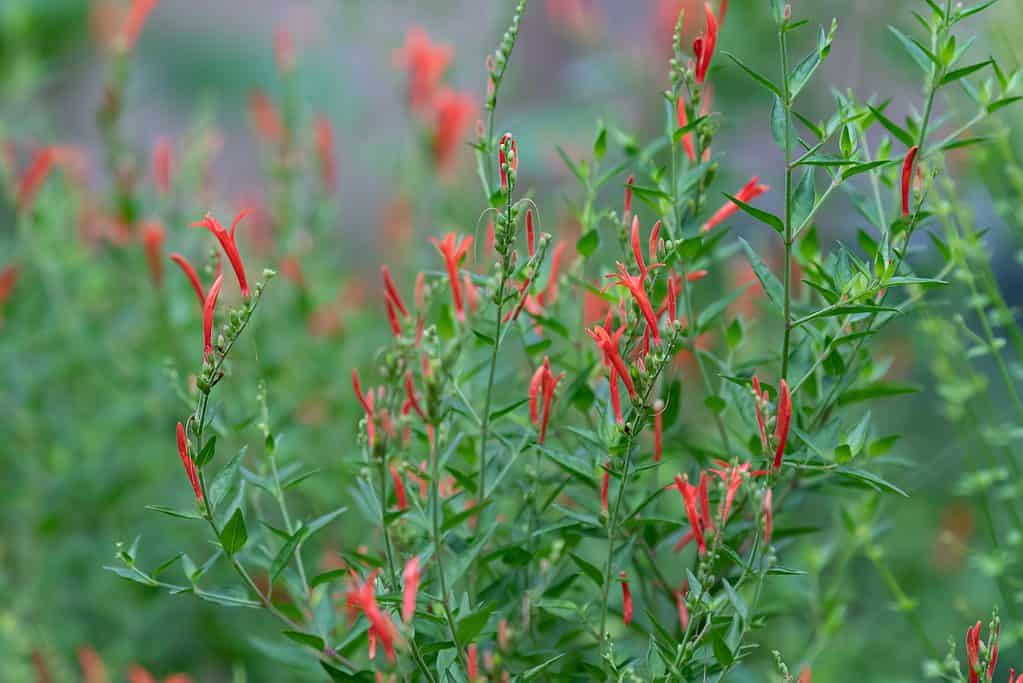
Flame acanthus is drought-tolerant and heat-loving.
©Marianne Pfeil/Shutterstock.com
7. Hardy Fuchsia (Fuchsia spp.)
Hardy fuchsias, members of the Fuchsia genus, are a group of deciduous shrubs and perennials prized for their elegant flowers that come in various shades of red, pink, and purple. These vibrant blooms, often characterized by their distinctive tubular shape, are a favorite of hummingbirds and a stunning addition to front yards and landscapes.
Hardy fuchsias produce pendulous and tubular blooms with colorful petals that often combine shades of red, pink, and purple. These elegant blooms dangle gracefully from the branches and provide an abundant source of nectar for hummingbirds. Additionally, their foliage is often serrated and deep green. However, some varieties have variegated or bronzy foliage, adding to their overall appeal.
The perennials grow best in partial to full shade, especially in regions with hot summers. They also love well-draining and consistently moist but never waterlogged soil. Plant hardy fuchsias as a focal point in shrub borders. Due to their compact size, some varieties are also suitable for container gardening.
Prune specimens in the late winter or early spring to remove dead or overgrown limbs and to shape the plant as desired. Deadheading spent flowers promotes extended blooming.
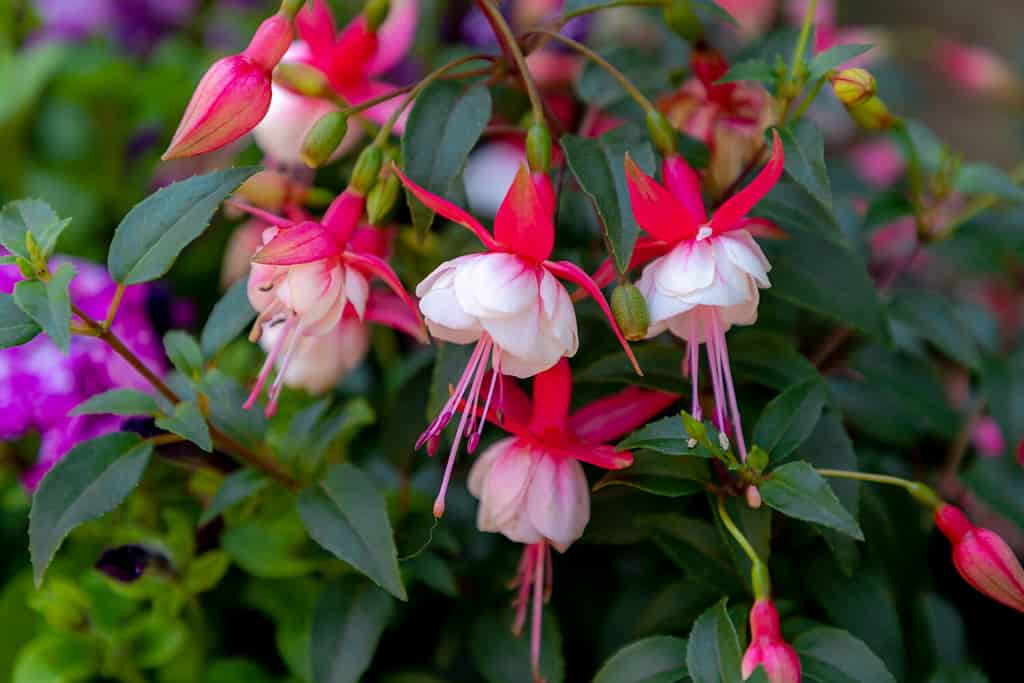
Fuchsia shrubs can reach up to 13 feet tall.
©Wut_Moppie/Shutterstock.com
8. Red Buckeye (Aesculus pavia)
Red buckeye is a striking deciduous shrub or small tree native to the southeastern United States. The standout feature of red buckeye is its showy red flowers, which are borne in upright clusters or panicles. These tubular blossoms are a magnet for hummingbirds and appear in spring, providing an early-season nectar source.
Its foliage consists of opposite, palmately compound leaves with five leaflets. Plant red buckeye in woodland gardens, where it thrives in partial to full shade. Additionally, incorporate specimens into native plant landscapes to support local wildlife. It also makes a great specimen plant in larger gardens or a focal point in landscape design.
Red Buckeye prefers partial to full shade and well-draining soil. However, it grows best in consistently moist soil. Prune as needed to maintain the plant’s shape and remove any dead or damaged branches. Minimal pruning is typically required for the low-maintenance shrub.
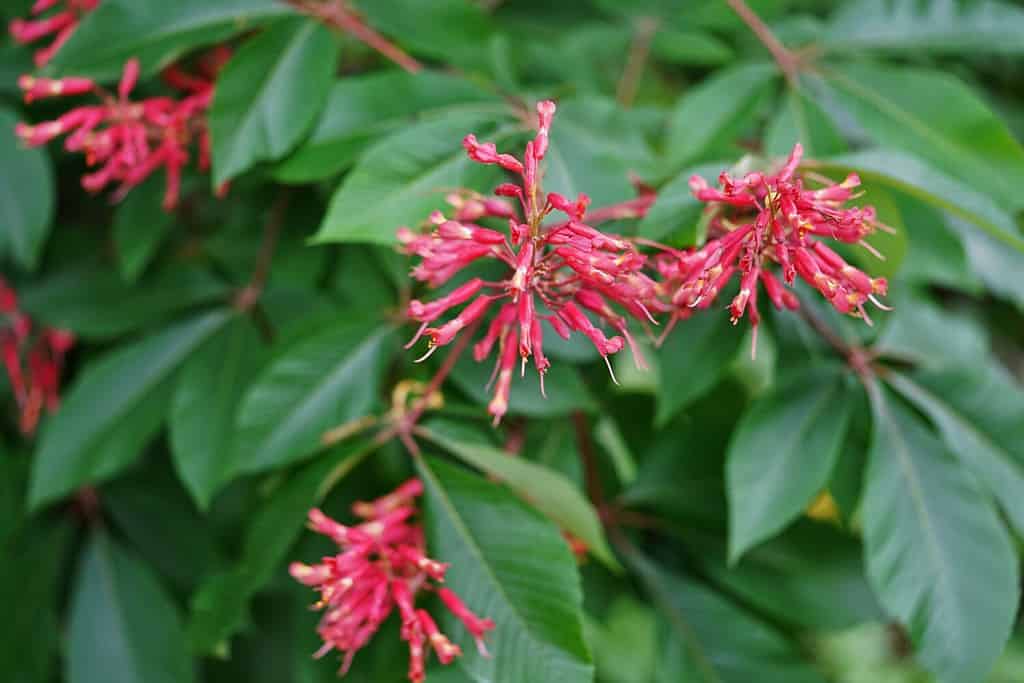
Early settlers used red buckeye roots to make soap for washing clothing.
©EQRoy/Shutterstock.com
9. Red Hot Poker (Kniphofia spp.)
Red hot poker, represented by various species within the Kniphofia genus, is a striking perennial known for its tall spikes. Its tubular flowers are arranged in dense spikes that can reach up to 6 feet. The color of the flowers varies by species and cultivar and includes shades of red, orange, yellow, and even bi-color combinations.
Additionally, the foliage of red hot poker is typically grass-like, forming clumps of long, narrow leaves. Plant specimens in perennial borders to create dramatic vertical accents and attract hummingbirds to your garden. Its tall spikes and striking flowers are also an intriguing addition to rock gardens and mixed beds.
Red hot poker grows best in full sun and well-draining but moist soil. Adequate moisture helps promote growth and flowering. Deadhead spent flowers to encourage additional blooming and trim back the foliage as needed to maintain an attractive appearance.
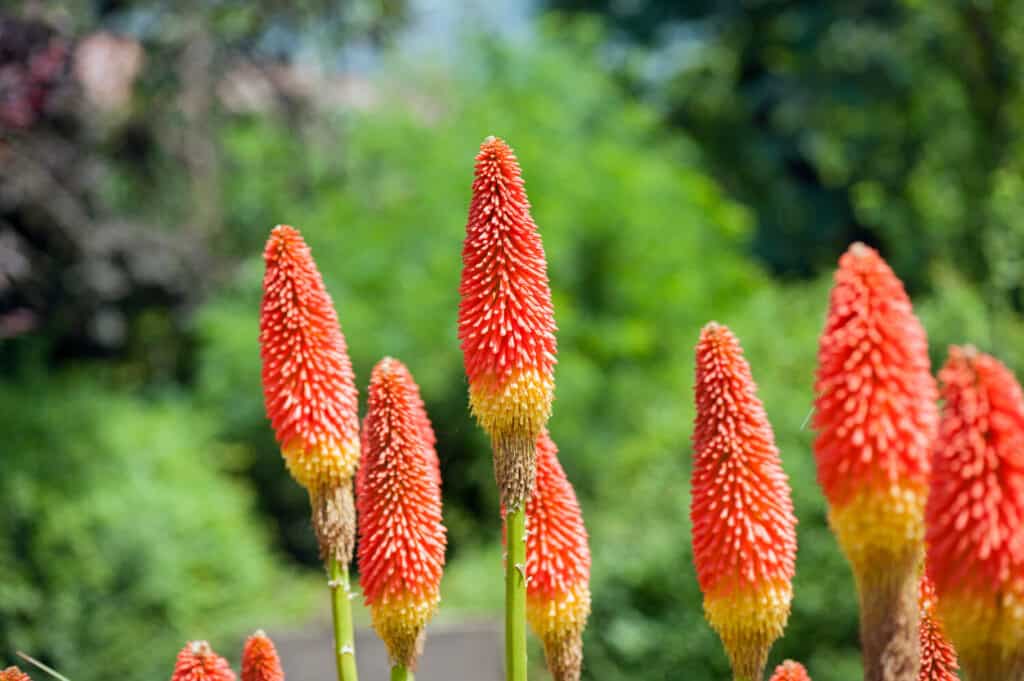
Red hot poker grows best in warm desert regions.
©costagliola/Shutterstock.com
10. Scarlet Bee Balm (Monarda didyma)
Scarlet bee balm is a native North American perennial plant that is well-loved for its striking red blooms but also its fragrance. Bee balm’s distinctive, tubular-shaped flowers are a magnet for hummingbirds and are perfectly adapted for the hummingbirds’ long, slender bills. The vibrant red petals and contrasting dark green, serrated leaves make bee balm an eye-catching centerpiece in your garden.
The perennial thrives in well-drained soil and partial to full sunlight. It is a hardy plant that can reach up to 4 feet, creating a dynamic presence in your garden. Regular deadheading prolongs the blooming season, which typically spans from late spring to early summer. Bee Balm is also known for its medicinal properties in herbal teas. Plant specimens in beds, borders, and containers.
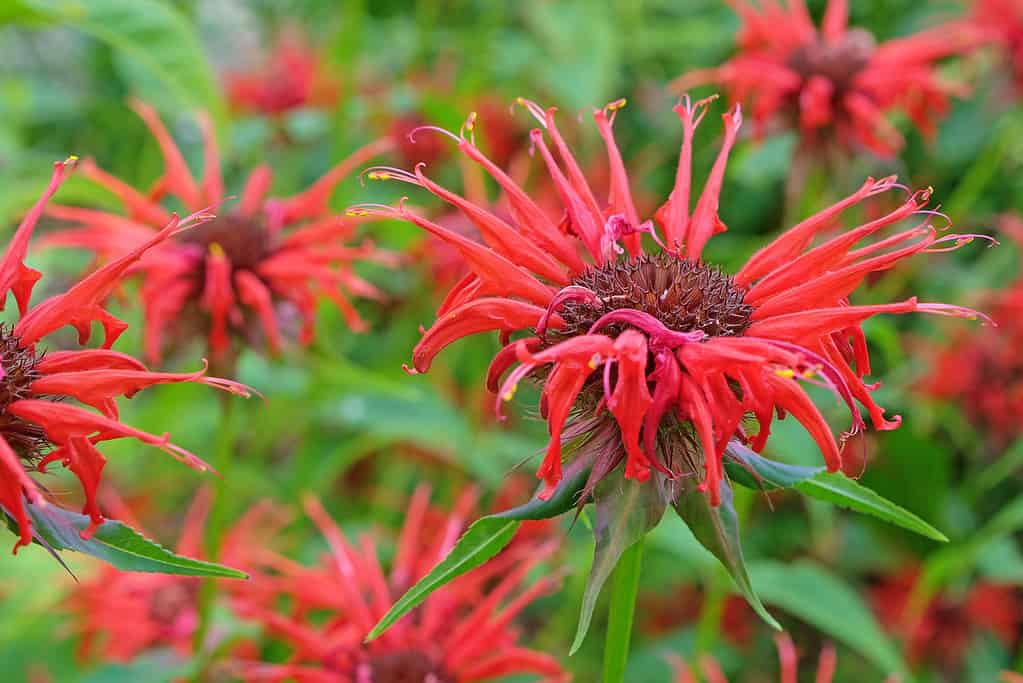
Find scarlet bee balm growing along ponds, lakes, and rivers in the wild.
©Alex Manders/ via Getty Images
11. Scarlet Gilia (Ipomopsis aggregata)
Another native wildflower found in various regions of North America, scarlet gilia, also known as skyrocket, produces tubular, scarlet-red flowers along slender, wiry stems. These elegant blossoms hang gracefully, inviting hummingbirds to sip nectar from late spring through summer.
Specimens also produce fine, feathery leaves that are medium green. Include scarlet gilia in wildflower gardens and naturalistic or meadow-style landscapes. They can also be an appealing addition to rock gardens, adding a touch of color and grace to rocky areas.
Provide full sun for the best blooming results. Scarlet gilia thrives in moist, well-draining soil. The biennials self-seed and are low-maintenance. Mature specimens reach up to 3 feet and are disease- and pest-free.
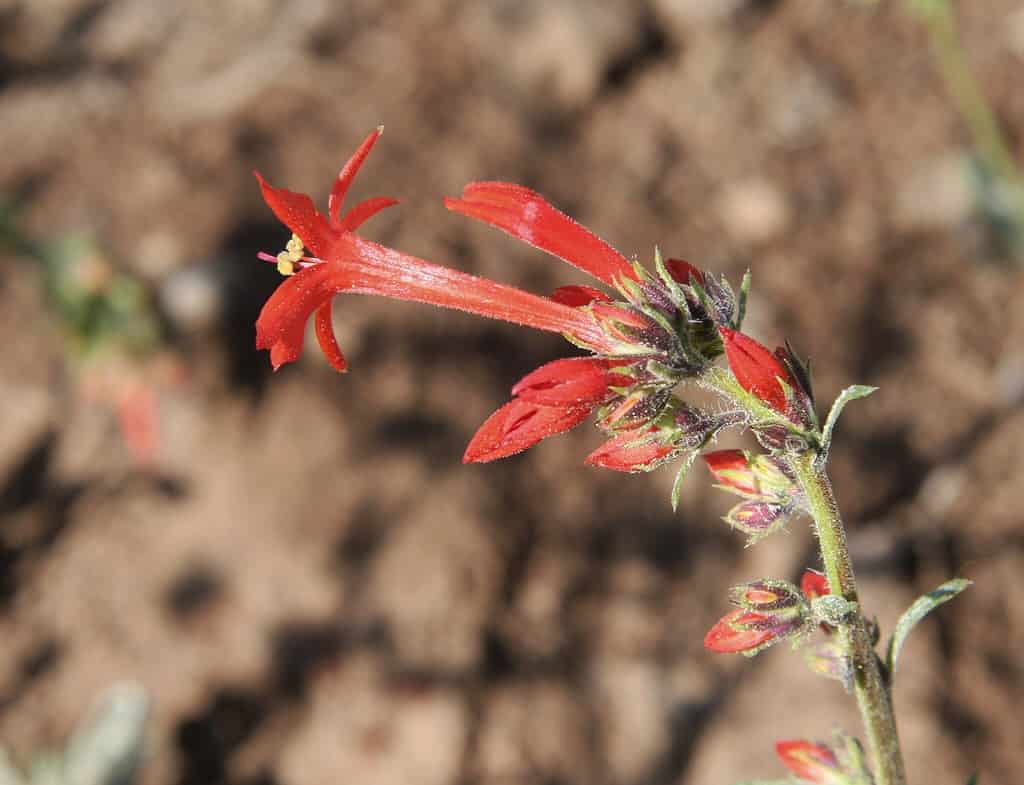
Scarlet gilia is a biennial or short-lived perennial.
©Dcrjsr, CC BY-SA 3.0 , via Wikimedia Commons – Original / License
12. Scarlet Monkeyflower (Mimulus cardinalis)
The scarlet monkeyflower is an aquatic perennial that is cherished for its brilliant scarlet-red flowers. It produces tubular blooms that often have attractive golden markings on the throat. These striking blossoms are a favorite of hummingbirds and bloom profusely from late spring through summer.
Its foliage consists of deep green, lance-shaped leaves that form a dense mound. Mature specimens grow to 3 feet tall and wide. Plant scarlet monkeyflower near water features, such as ponds, streams, or boggy areas, where it thrives in moist soil conditions. Additionally, include this native beauty in native gardens to attract hummingbirds and pollinators.
Scarlet monkeyflower grows best in partial to full sun, especially in regions with cooler summers. However, in hot climates, partial shade during the hottest part of the day is beneficial. Well-draining, moist soil is essential, and regular watering is important to maintain the plant’s health and ensure abundant blooming. Prune back the plant after flowering to encourage bushier growth and potentially extend the blooming season.
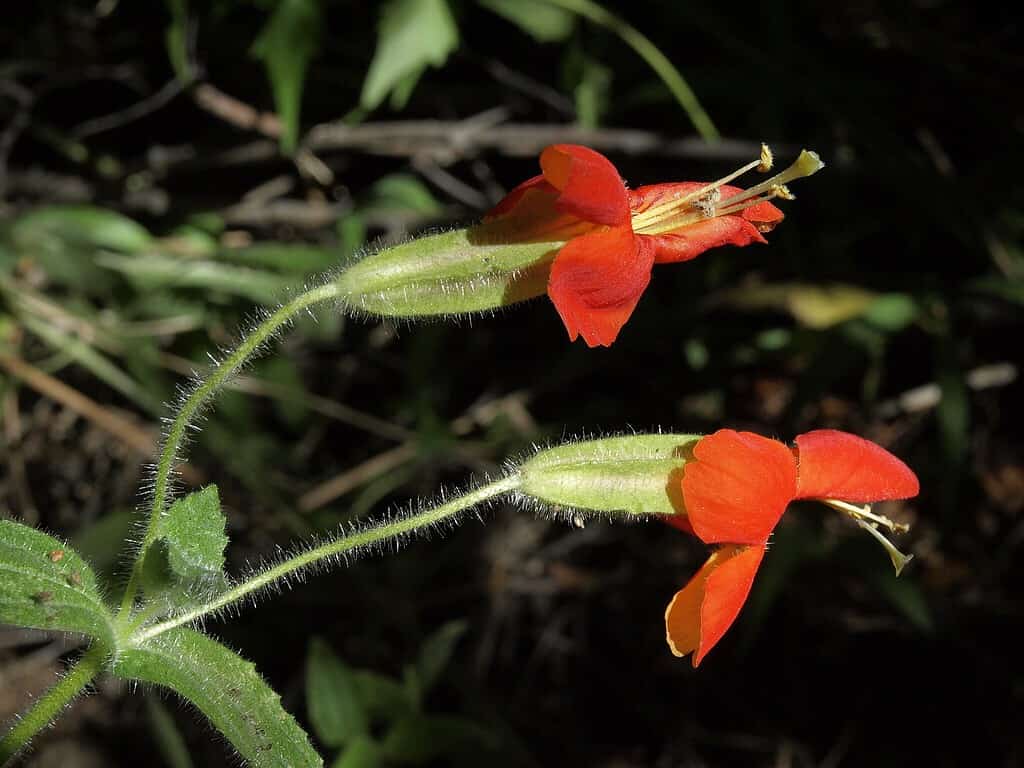
The scarlet monkeyflower is a busy deciduous shrub.
©Jim Morefield from Nevada, USA, CC BY-SA 2.0 , via Wikimedia Commons – Original / License
13. Scarlet Sage (Salvia coccinea)
Scarlet sage is an annual or tender perennial that brightens up gardens with its vibrant red flowers. It produces tubular flowers on tall spikes that reach two feet tall. These vibrant blossoms appear from late spring through fall, providing a consistent source of nectar for hummingbirds.
Its foliage consists of lance-shaped, dark green leaves. Plant scarlet sage in cottage-style gardens, where its bright red flowers create a classic and romantic look. Additionally, combine specimens with other annuals, perennials, or shrubs to add color and vertical interest to mixed borders.
Scarlet sage thrives in well-draining soil and full sun. It tolerates various soil types but prefers consistent moisture. Deadhead spent flowers to encourage additional blooming and prune back the plant as needed to maintain a tidy appearance.
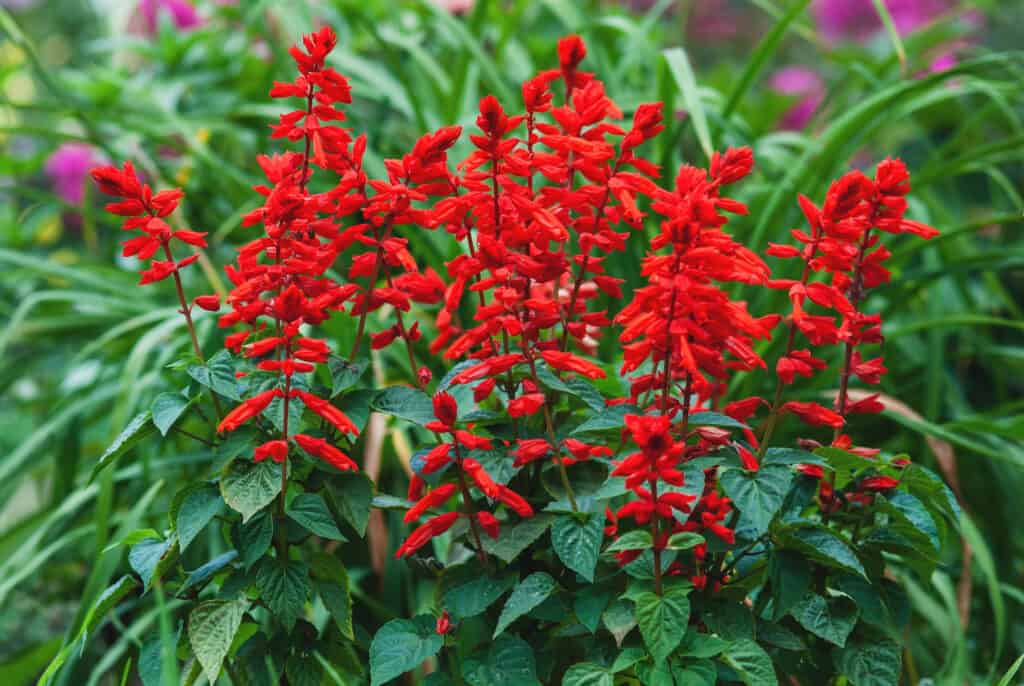
Scarlet sage blooms resemble hummingbirds, while its extended stamens resemble their beaks.
©iStock.com/Nadya So
14. Texas Indian Paintbrush (Castilleja indivisa)
Texas Indian paintbrush is another captivating wildflower and North American native. This annual wildflower produces bright red, tubular bracts that surround inconspicuous flowers. These bracts create a stunning display, mimicking an artist’s paintbrush dipped in vibrant pigment. The vivid coloration of the bracts is a visual lure for hummingbirds.
The plant also produces lance-shaped, bright green leaves that serve as a backdrop to the colorful bracts. Plant this native beauty in native and wildflower gardens to introduce a splash of red and attract hummingbirds and pollinators. It also thrives in naturalistic or meadow-style landscapes and is adaptable to xeriscape gardens, thriving with minimal water once established.
Texas Indian paintbrushes love full sun and well-draining soil. In the wild, it grows best in nutrient-poor environments. It is also incredibly low-maintenance and disease- and pest-free.
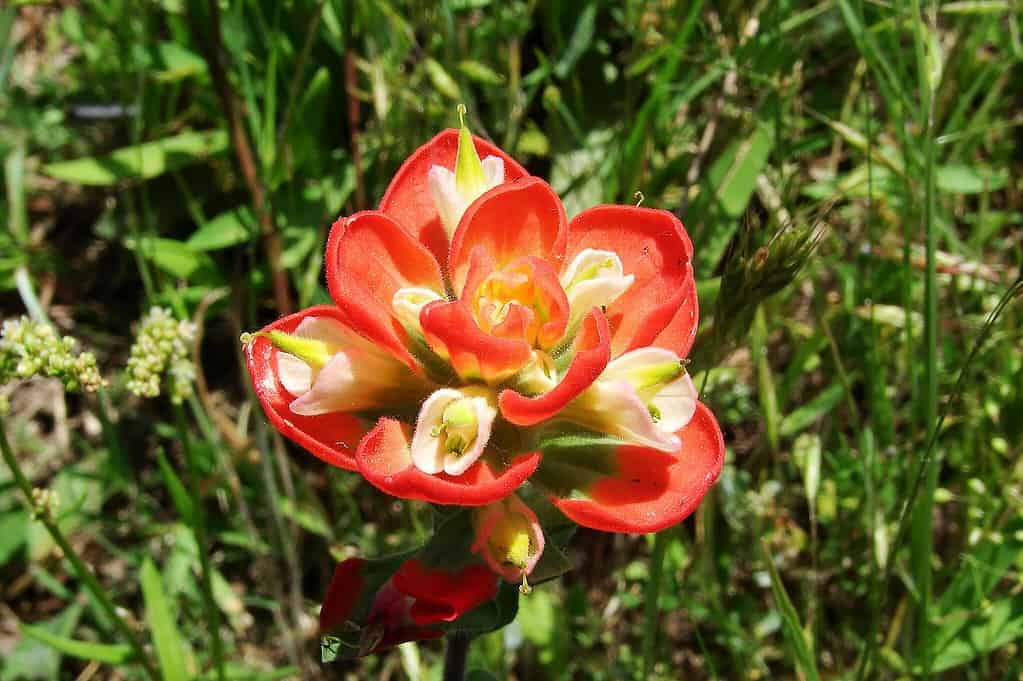
Native Americans used the Texas Indian paintbrush for medicinal purposes.
©Loadmaster (David R. Tribble)This image was made by Loadmaster (David R. Tribble).Email the author: David R. TribbleAlso see my personal gallery at Google Photos, CC BY-SA 3.0 , via Wikimedia Commons – Original / License
15. Trumpet Vine (Campsis radicans)
Also known as trumpet creeper or trumpet climber, trumpet vine is a vigorous and fast-growing woody vine renowned for its large, trumpet-shaped flowers that come in vibrant shades of red, orange, or yellow. Its blooms appear in clusters along the vine, and these showy blossoms provide a bountiful source of nectar for hummingbirds, blooming from late spring through summer.
Its foliage consists of pinnately compound, dark green leaves. Train the vine to climb over arbors and trellises to create a stunning floral canopy. Additionally, plant trumpet vines along fences to provide a burst of color or incorporate them into wildlife-friendly gardens to support pollinators.
Trumpet vine loves moist, well-draining soil and full sun. Prune specimens as needed to control their growth, remove dead or damaged branches, and shape the plant to your desired form. Trumpet vine reaches up to 40 feet tall, adding a stunning floral display to your landscape.
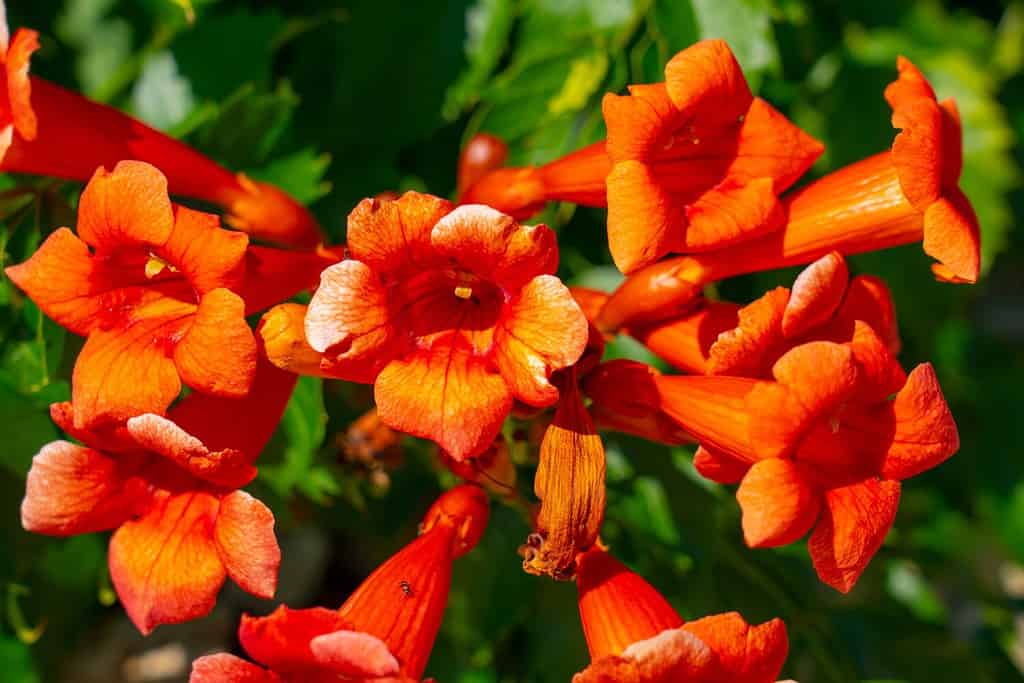
Trumpet vine is dense and fast-growing.
©martin.dlugo/Shutterstock.com
16. Turk’s Cap (Malvaviscus arboreus var. drummondii)
Turk’s cap, also known as wax mallow, is a unique perennial shrub native to the southern United States. It stands out with its vibrant red, tubular flowers that resemble a Turkish turban, giving it its name. Its foliage consists of dark green, deeply lobed leaves that create a lush backdrop for the vibrant red flowers.
Incorporate Turk’s cap into native plant gardens to support local wildlife. It thrives in partial to full shade, making it a valuable addition to shade gardens or areas with dappled sunlight. Additionally, combine Turk’s cap with other native perennials and shrubs to add color and texture to mixed borders.
Turk’s cap grows best in well-draining soil and prefers consistent moisture. Prune specimens as needed to control their size and shape. Deadheading spent flowers can encourage additional blooming. Mature specimens reach up to 5 feet and add a touch of exotic charm to outdoor spaces.

Turk’s cap produces small red fruits that are edible.
©NOPPHARAT9889/Shutterstock.com
17. Western Columbine (Aquilegia formosa)
This graceful perennial is native to the western United States. Western columbine grows up to 3 feet, producing unique and elegant red and yellow flowers that resemble hanging lanterns. These distinct blooms are a source of nectar for hummingbirds and a charming addition to native plant gardens and woodland settings.
Its foliage consists of lacy, bluish-green leaves that form a delicate backdrop. Plant western columbine in woodland gardens. Furthermore, include this native wildflower in native plant landscapes to attract hummingbirds and create a naturalistic, wildlife-friendly garden. It also makes a great addition to rock gardens.
Western columbine thrives in moist, well-draining soil. It also prefers full shade for the best blooms. Adequate moisture promotes healthy growth and flowering. However, western columbine does not tolerate waterlogged roots. Deadhead spent flowers to encourage additional blooming and prune back the plant as needed to maintain its graceful form.
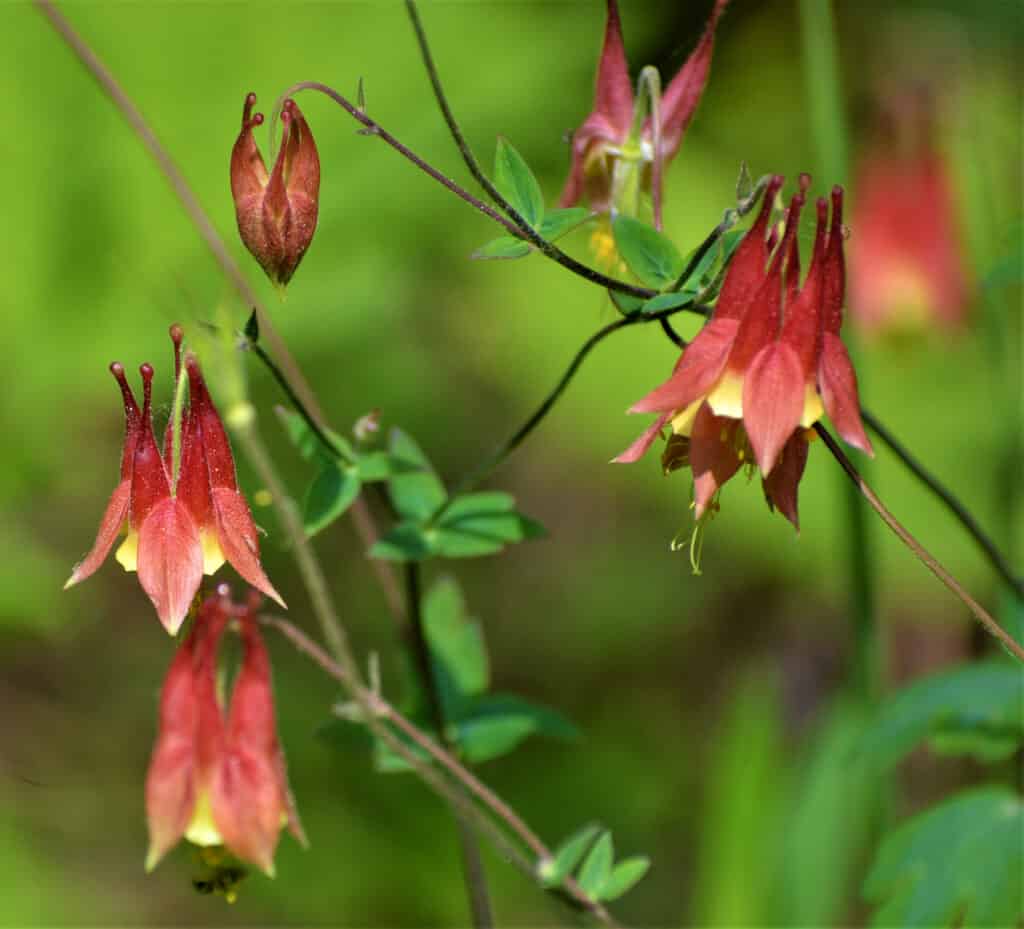
In Latin,
Aquilegiameans eagle and refers to the plant’s petals that resemble talons.
©akslocum/Shutterstock.com
18. Zinnia (Zinnia spp.)
Zinnias, represented by various species within the Zinnia genus, are beloved annual flowers renowned for their vibrant and diverse array of colors, including shades of red. These cheerful, daisy-like blooms are a source of nectar for hummingbirds and are cherished for their long-lasting, colorful displays in gardens and floral arrangements.
Blooms come in various shapes and sizes, including single, semi-double, and double forms. In shades of red, they offer a spectrum of hues from deep scarlet to bright crimson. Zinnias typically have a central disc surrounded by colorful petals. Furthermore, the foliage typically consists of opposite, lance-shaped leaves that are usually medium to dark green.
Zinnias offer several landscape uses. Cut mature specimens to enjoy their colorful blooms in floral arrangements. Additionally, incorporate zinnias into mixed borders or containers. They grow best in full sun and well-draining soil.
Keep the soil consistently moist, especially during dry spells. Adequate moisture promotes healthy growth and continuous flowering. Deadhead spent flowers to encourage additional blooming and pinch back the plant to maintain its shape and prevent it from becoming leggy.
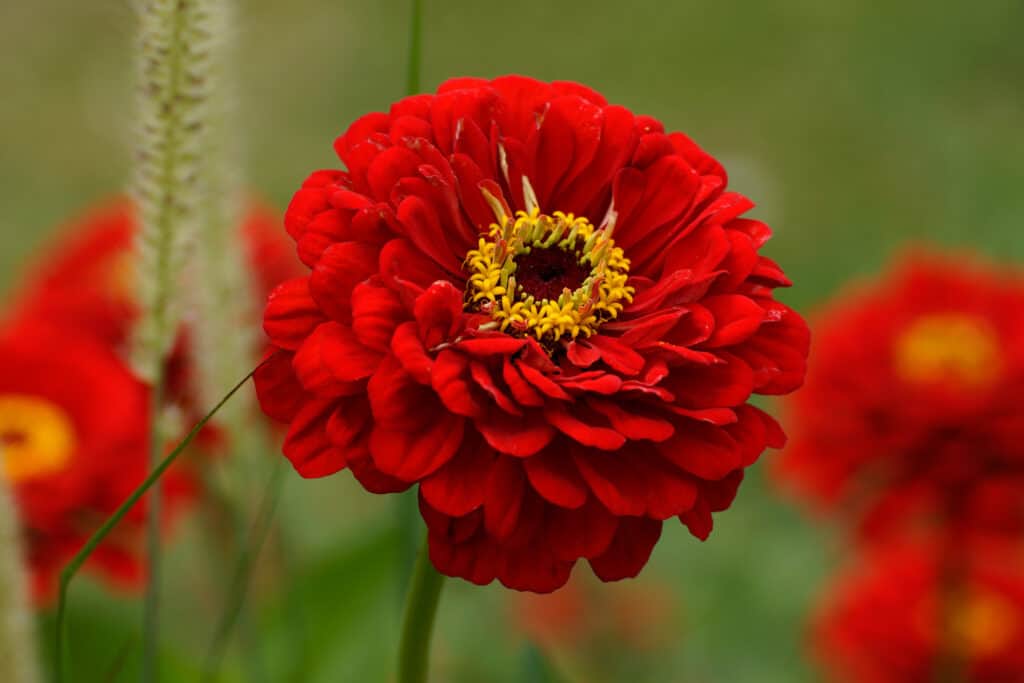
Zinnias may not have the usual shape that attracts hummingbirds, but they are actually a rich nectar source for the birds.
©iStock.com/Helena Bezold
Summary of 18 Red Flowers That Attract Hummingbirds
| Number | Common Name | Hardiness Zones |
|---|---|---|
| 1 | Bat-Faced Cuphea | 9 – 12 |
| 2 | Cardinal Flower | 2 – 9 |
| 3 | Coral Honeysuckle | 4 – 9 |
| 4 | Firecracker Penstemon | 4 – 10 |
| 5 | Firecracker Plant | 9 -11 |
| 6 | Flame Acanthus | 8 – 10 |
| 7 | Hardy Fuchsia | 6 – 10 |
| 8 | Red Buckeye | 5 – 9 |
| 9 | Red Hot Poker | 5 – 9 |
| 10 | Scarlet Bee Balm | 4 – 9 |
| 11 | Scarlet Gilia | 4 – 9 |
| 12 | Scarlet Monkeyflower | 5 – 10 |
| 13 | Scarlet Sage | 8 – 10 |
| 14 | Texas Indian Paintbrush | 3 – 9 |
| 15 | Trumpet Vine | 4 – 9 |
| 16 | Turk’s Cap | 8 – 11 |
| 17 | Western Columbine | 3 – 9 |
| 18 | Zinnia | 3 – 10 |
Thank you for reading! Have some feedback for us? Contact the AZ Animals editorial team.

